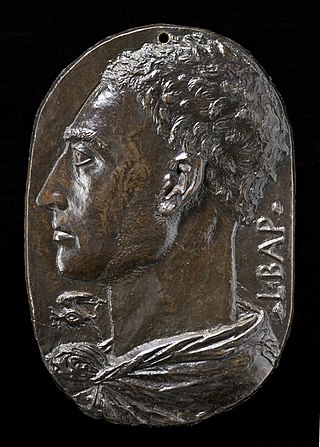
Leon Battista Alberti was an Italian Renaissance humanist author, artist, architect, poet, priest, linguist, philosopher, and cryptographer; he epitomised the nature of those identified now as polymaths. He is considered the founder of Western cryptography, a claim he shares with Johannes Trithemius.
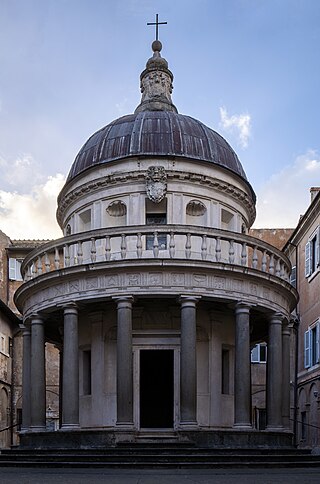
Renaissance architecture is the European architecture of the period between the early 15th and early 16th centuries in different regions, demonstrating a conscious revival and development of certain elements of ancient Greek and Roman thought and material culture. Stylistically, Renaissance architecture followed Gothic architecture and was succeeded by Baroque architecture and neoclassical architecture. Developed first in Florence, with Filippo Brunelleschi as one of its innovators, the Renaissance style quickly spread to other Italian cities. The style was carried to other parts of Europe at different dates and with varying degrees of impact.

Jacopo Bellini was one of the founders of the Renaissance style of painting in Venice and northern Italy. His sons Gentile and Giovanni Bellini, and his son-in-law Andrea Mantegna, were also famous painters.

Ludovico III Gonzaga of Mantua, known as the Turk, also spelled Lodovico was the ruler of the Italian city of Mantua from 1444 to his death in 1478.
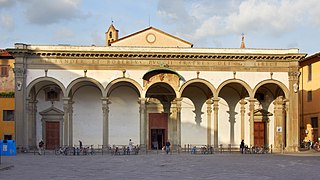
The Basilica della Santissima Annunziata is a Renaissance-style, Catholic minor basilica in Florence, region of Tuscany, Italy. This is considered the mother church of the Servite Order. It is located at the northeastern side of the Piazza Santissima Annunziata near the city center.

Benozzo Gozzoli was an Italian Renaissance painter from Florence. A pupil of Fra Angelico, Gozzoli is best known for a series of murals in the Magi Chapel of the Palazzo Medici-Riccardi, depicting festive, vibrant processions with fine attention to detail and a pronounced International Gothic influence. The chapel's fresco cycle reveals a new Renaissance interest in nature with its realistic depiction of landscapes and vivid human portraits. Gozzoli is considered one of the most prolific fresco painters of his generation. While he was mainly active in Tuscany, he also worked in Umbria and Rome.

Giuliano da Sangallo was an Italian sculptor, architect and military engineer active during the Italian Renaissance. He is known primarily for being the favored architect of Lorenzo de' Medici, his patron. In this role, Giuliano designed a villa for Lorenzo as well as a monastery for Augustinians and a church where a miracle was said to have taken place. Additionally, Giuliano was commissioned to build multiple structures for Pope Julius II and Pope Leo X. Leon Battista Alberti and Filippo Brunelleschi heavily influenced Sangallo and in turn, he influenced other important Renaissance figures such as Raphael, Leonardo da Vinci, his brother Antonio da Sangallo the Elder, and his sons, Antonio da Sangallo the Younger and Francesco da Sangallo.
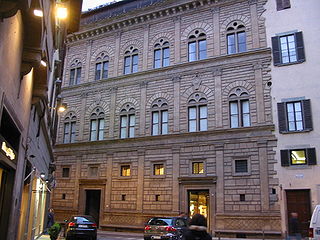
Palazzo Rucellai is a palatial fifteenth-century townhouse on the Via della Vigna Nuova in Florence, Italy. The Rucellai Palace is believed by most scholars to have been designed for Giovanni di Paolo Rucellai by Leon Battista Alberti between 1446 and 1451 and executed, at least in part, by Bernardo Rossellino. Its splendid facade was one of the first to proclaim the new ideas of Renaissance architecture based on the use of pilasters and entablatures in proportional relationship to each other. The Rucellai Palace demonstrates the impact of the antique revival but does so in a manner which is full of Renaissance originality.
Luca Fancelli was an Italian architect and sculptor.
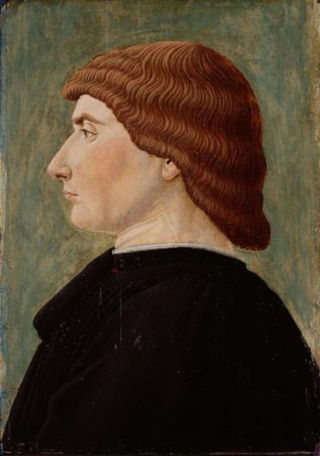
Fra Carnevale OP was an Italian painter of the Quattrocento, active mainly in Urbino. Widely regarded as one of the most enigmatic artists, there are only nine works that can be definitively attributed to Carnevale known of today. Most of these have even been contested as authentic to Carnevale at various points in history.

The Policlinico of Milan also known as Ospedale Maggiore di Milano or Ca' Granda Ospedale Maggiore Policlinico, is the public district general hospital in Milan, It is one of the oldest hospitals in Italy, founded by Duke Francesco Sforza in 1456. Today it is a modern hospital with 900 beds, with wards for adults, pregnant women and children. During the first COVID-19 breakout in March 2020, 300 of those beds were readapted for COVID-19 patients.
The decade of the 1460s in art involved some significant events.
The decade of the 1450s in art involved many significant events, especially in sculpture.
Nationality words link to articles with information on the nation's poetry or literature.

Paolo Barbo (1416–1462) was a Venetian patrician, diplomat and statesman. An educated humanist of the well connected Barbo and Condulmer families, he was the nephew of Pope Eugene IV and the brother of Pope Paul II.












